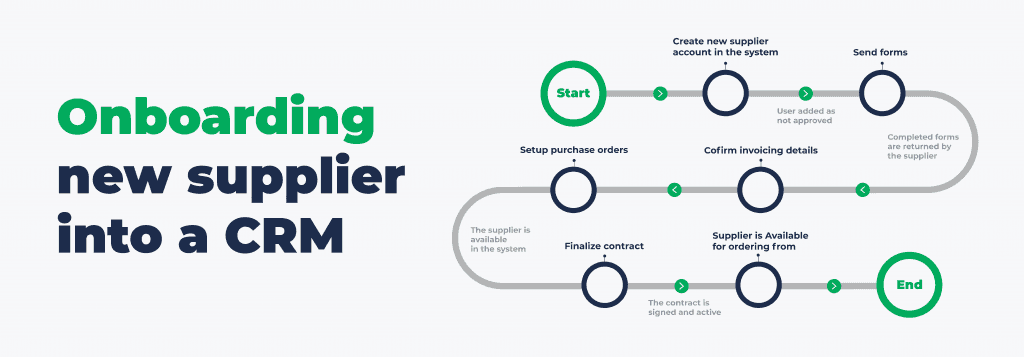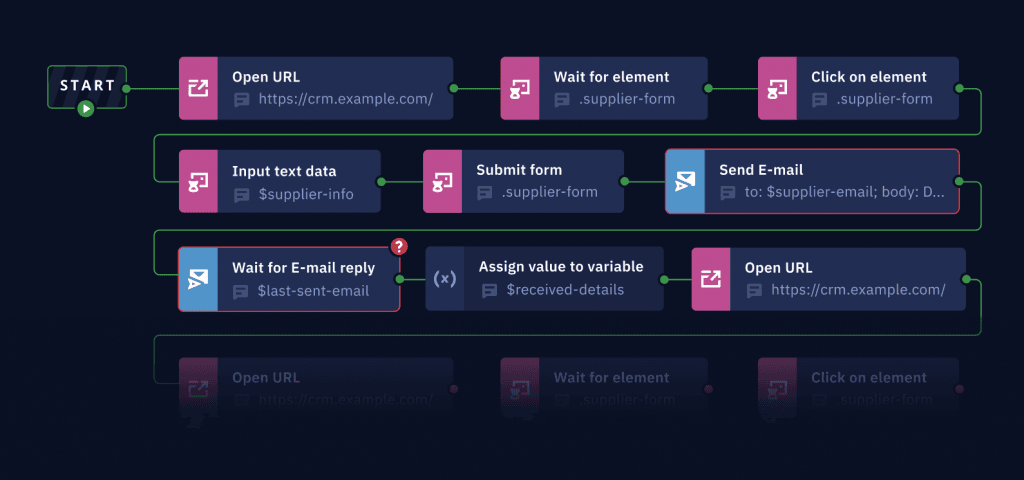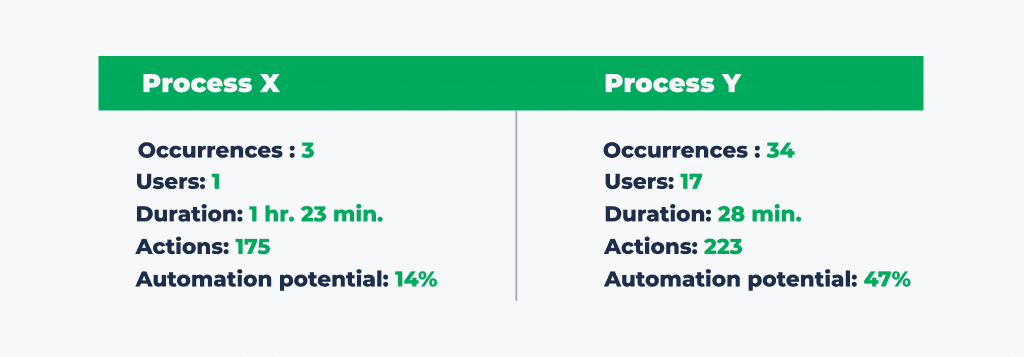You Can Continue the Process of Discovery and Intention by
To build any automation, we need to have a clear understanding of today's workflow. This is precisely what process discovery is for. In this article, we'll answer what process discovery is and see how it fits within your automation journey and an RPA practice in particular.
What is business process discovery?
Consider process discovery as an x-ray of a company's business processes. With process discovery tools, you can identify automation opportunities and gain actionable data for prioritizing these opportunities.
An illustration below shows a sample of a "discovered" workflow. This flowchart graphically represents the flow of a new supplier onboarding process from the data coming from events and activities.

Process discovery also allows you to learn how exactly those processes work and what happens between their various steps. The ultimate goal of automated process discovery is to extract real-world information on typical steps taken within a digital workflow and turn it into visual workflow diagrams that might later become a foundation for an automated workflow.

Digital process mining vs. process discovery: What's the difference?
Process mining and process discovery terms go hand in hand, as both techniques are used for identifying how business processes are working and further process optimization. Still, there are some noticeable differences.
There are two viewpoints on what each term actually means: one is accepted in the data science field, while the other is conventional for the RPA industry.
From the data science perspective, process mining is a more high-level term that refers to a research field. It includes three main activities aimed at extracting knowledge out of the available log files. One of these activities is process discovery; the rest are conformance checking and enhancement (or extension).
In the RPA industry, the two terms are considered as somewhat like the iPhone X and iPhone 13: similar techniques where process discovery is just a more up-to-date approach. The main difference there lies in the methods of identifying how a business process works.
Process mining, in this case, describes workflows based on the events logged in the process by some enterprise system. For an online retailer, these events could be: order registration, payment, order processing, wrapping, shipping, etc.
Process discovery in RPA analyzes processes' digital footprint: it captures low-level operational data from employees' machines. This includes the apps opened, the clicks made, the information copied and pasted, etc.
How process discovery works for RPA: Principles and tools
Process discovery consists of three main steps that will take you from a newly-found workflow that makes a suitable candidate for automation to actual hands-on automation. To illustrate these steps, we'll use ElectroNeek's robotic process automation tools as an example.
To perform process discovery, ElectroNeek employs the capabilities of Bot Runner, a free app for launching RPA bots. When you purchase access to the Productivity Analytics tool, it gains extra functionality and can also be used as an agent for process discovery. Let's see how it works.

Step 1: Activity recording
In this step, we choose the business users to record their activities. To do so, we install and deploy Bot Runners (with enabled access from Productivity Analytics) on their workstations. Once it's done, the product starts to track and gather information about the time the users spend in different applications and the nature of their actions.
Step 2: Process analysis
All the information collected by Bot Runner is sent to the ElectroNeek portal (a web app), where an algorithm clusters information together and evaluates automation opportunities.
NOTE: The bot doesn't collect any actual data the users work with, captures any typed text, or makes any screenshots. The Productivity Analytics tool is only interested in the nature of users' actions (copying, pasting, pressing keystrokes, etc.). For example, a user fills out various forms in a CRM system four hours per day — this looks like a workflow that could be automated. But if the user occasionally opens a folder to delete a couple of photos, it's irrelevant as it takes little time and a couple of clicks.
The tool analyzes the recorded processes and displays the statistics on a special dashboard for the business analyst to go through. In this dashboard, you'll see a list of workflows with the number of occurrences, the average time consumed, and the number of users who perform the process.
Once the business analyst collects enough data, they review the discovery results and decide which workflows can potentially provide the best ROI for the organization and are suitable for further automation.

Step 3: Automation
The next step is to turn the statistics into an actionable fact-based task for RPA developers. Then, the RPA developers create and test an RPA bot; when the QA stage is passed, they make it available for employees to use.
Benefits of process discovery
Identifying and prioritizing processes for automation are among the challenges for RPA; process discovery comes to the rescue.
RPA process discovery makes sure you automate the right processes
Finding the right processes to automate is a rewarding task, as it's pretty expensive to automate the wrong procedures. With automated process discovery, you can correctly document the requirements needed to do the automation and map your processes out. It allows you to have a closer look at them and make sure you aren't automating inefficient work.
RPA process discovery provides clear reasoning for actions
As process discovery enables you to provide estimates on time and cost optimization thanks to each process automation, you can also track the impact of your RPA automation. If your company's goal is to reduce operational costs by a given percentage, you'll be able to forecast it accurately and measure how each of the automated workflows contributes to achieving the goal.
RPA process discovery helps you have a clear scope of work
Process discovery allows you to get the lay of the land, turning the vague need for digital transformation into a sequence of specific steps to reach the goal. Identifying the start and end points of any process is key to keeping the automation initiative manageable and focused.
To sum up
Process discovery is a critical phase that provides an understanding of the process, its current state, and bottlenecks. It can map out the dynamics regarding the potential productive time spent daily and contribute to developing strategies to derive higher productivity levels. Ideally, process discovery should always happen before any development work begins.
If you'd like to get started with intelligent data-driven automation, have a closer look at the ElectroNeek RPA platform. It provides the tools for end-to-end business processes automation, including process discovery tools, for both enterprises and smaller businesses through the help of managed service providers.
More than 100 companies in the banking, insurance, accounting, oil, and gas sectors have already reaped the benefits of ElectroNeek's process discovery abilities. If you're interested to learn more, feel free to get in touch.
willasonlonat1943.blogspot.com
Source: https://electroneek.com/blog/process-discovery/
0 Response to "You Can Continue the Process of Discovery and Intention by"
Post a Comment